Abstract
The stages of the complex events involved in exocytotic secretion after vesicle-cell membrane fusion have been examined at the level of individual vesicles. Catecholamine flux from single bovine adrenal medullary cells was measured with carbon-fiber microelectrodes firmly touching the cell surface. The data reveal that secretion during exocytotic events has three distinct stages: a small increase in catecholamine flux, a rapid, but not instantaneous, rise to a maximum, followed by an exponential decrease in the flux. These stages are interpreted in the following ways. The initial stage corresponds to catecholamine secretion through a fusion pore. The rate of pore expansion appears to control the rise time of the flux to its maximum value. The final exponential stage is consistent with chemical dissociation of the intravesicular matrix or gel.
Full text
PDF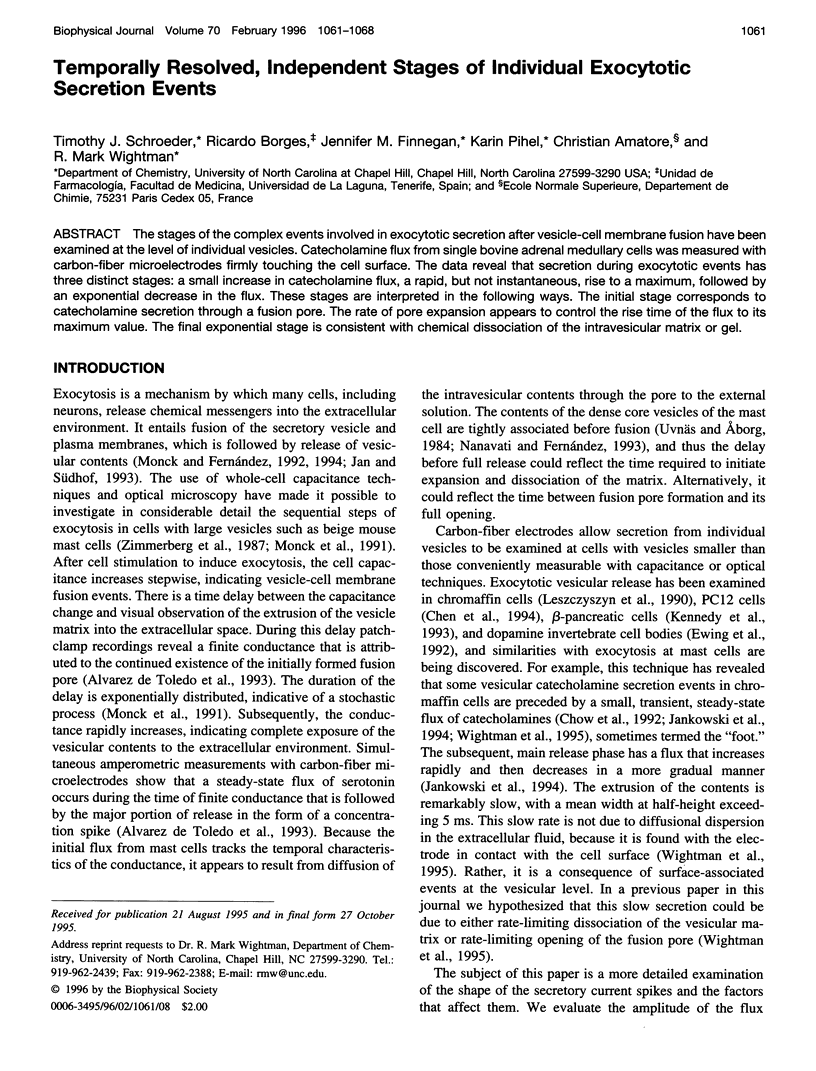
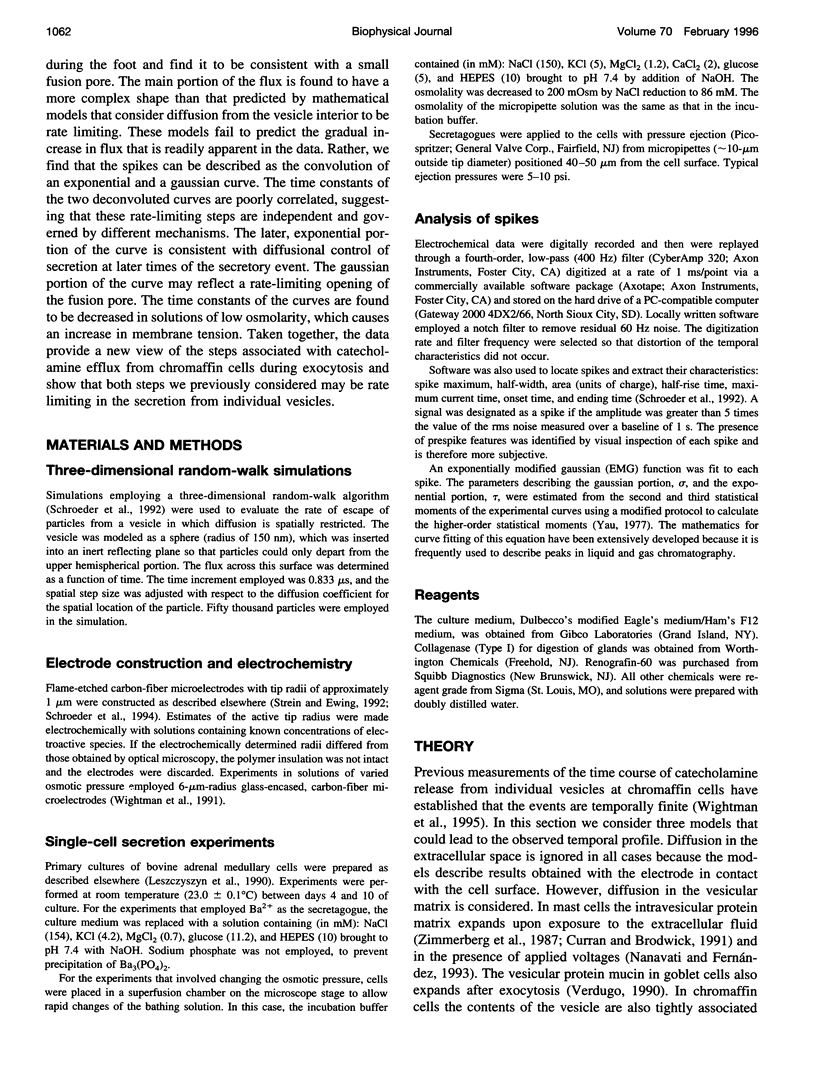
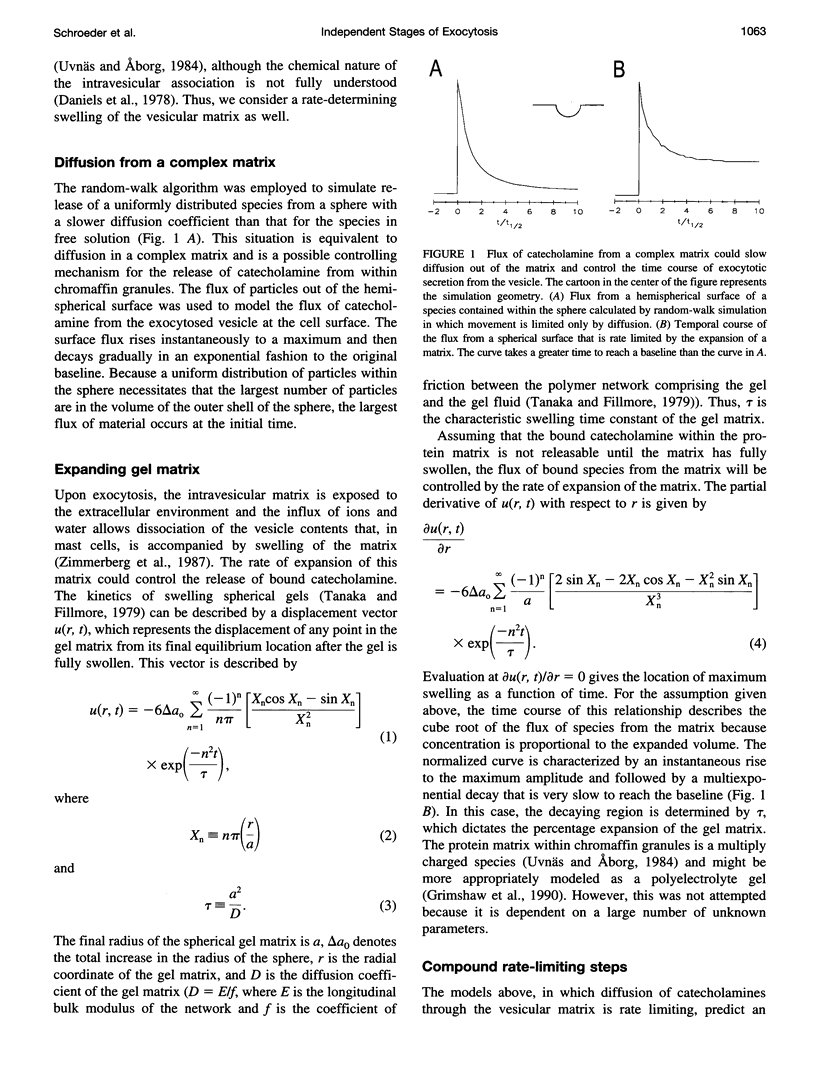
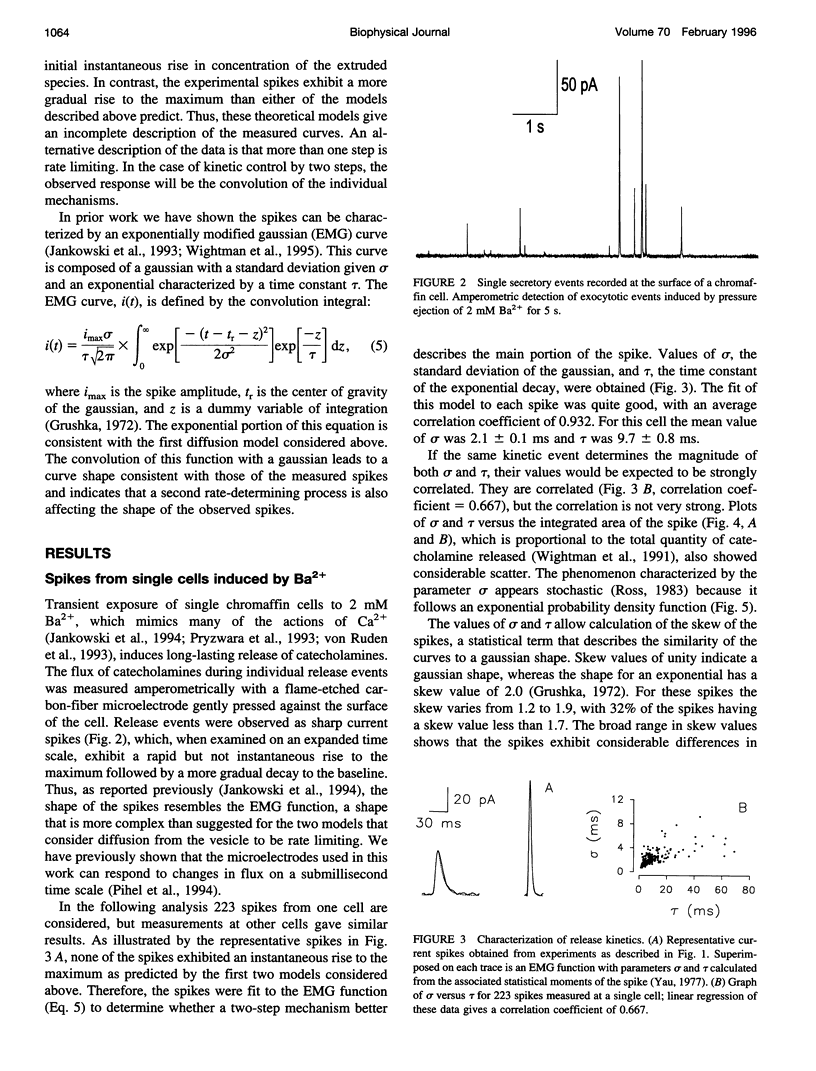
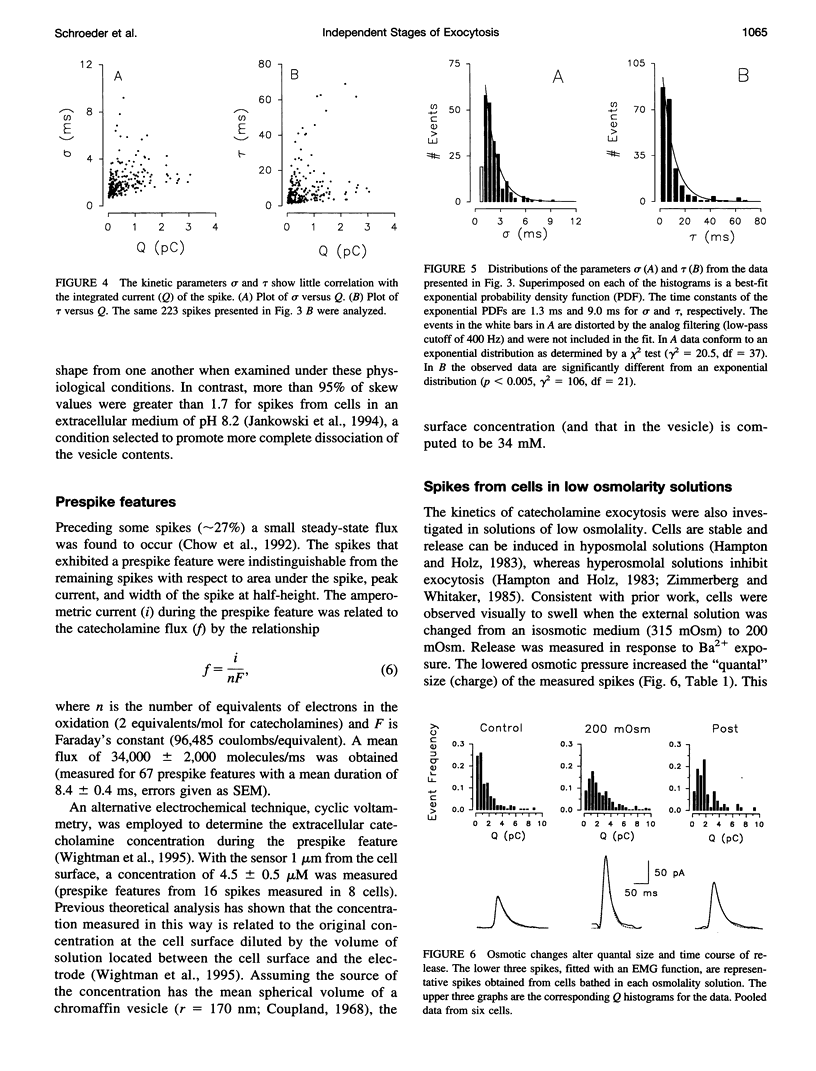

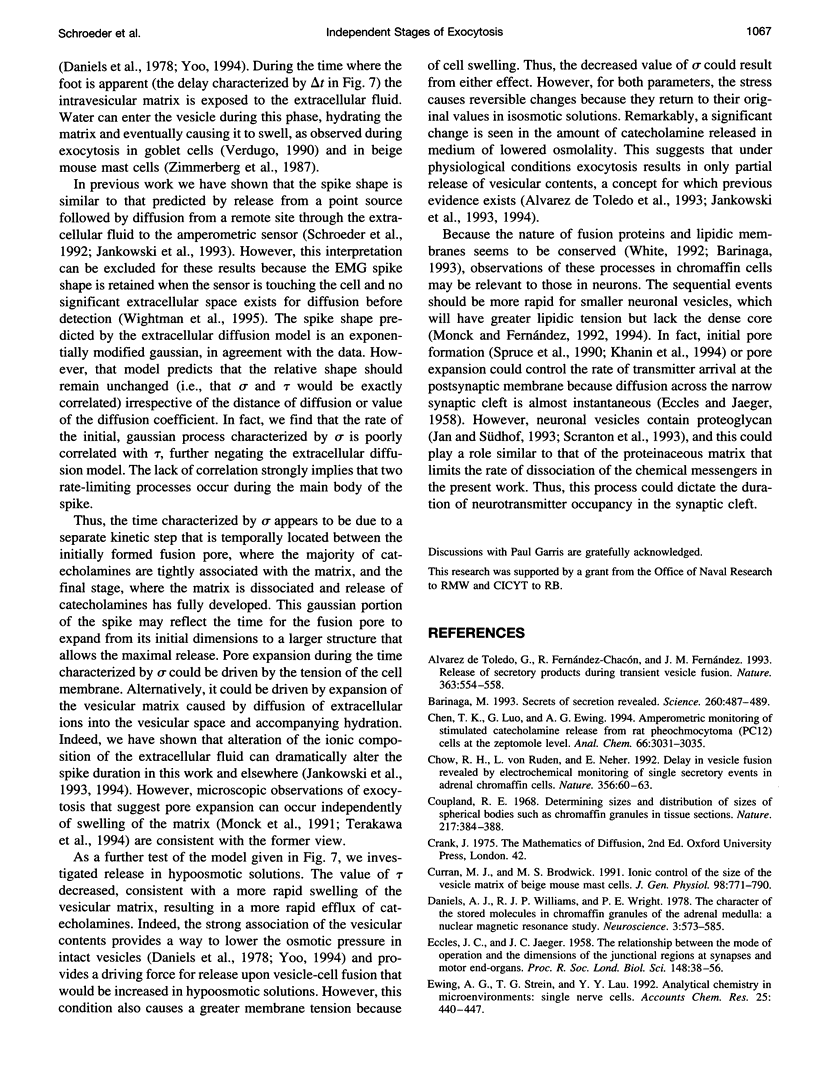
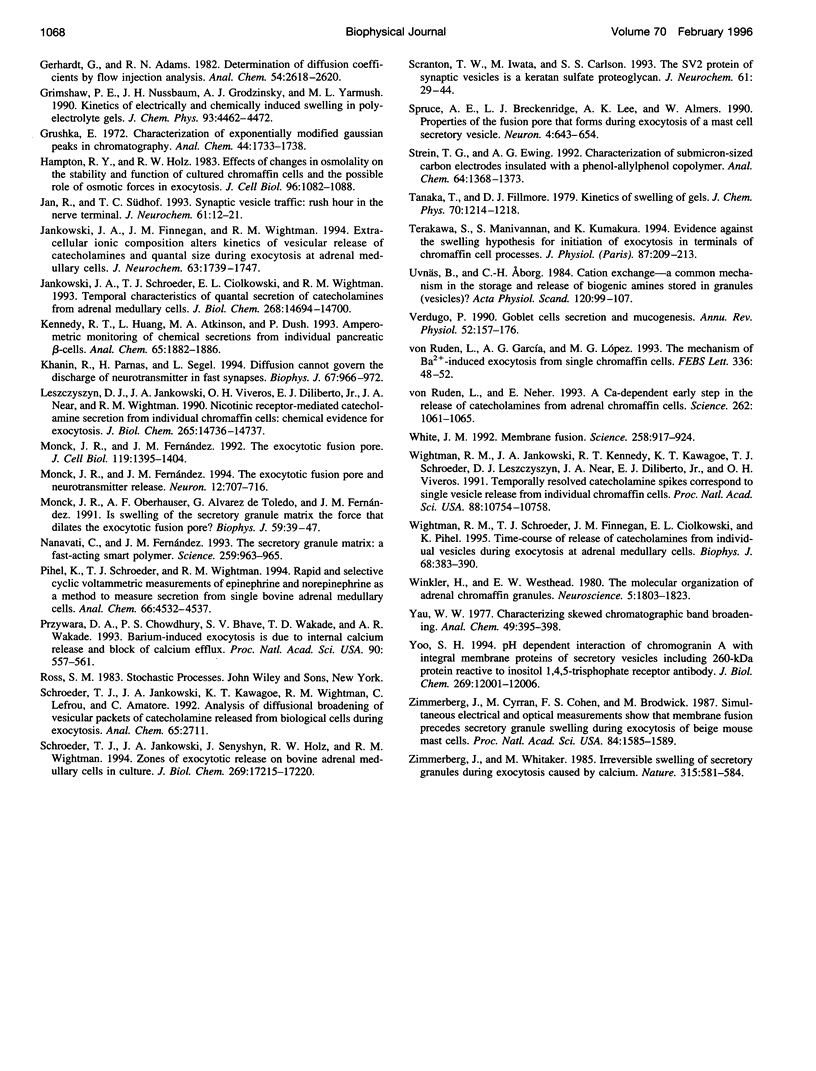
Images in this article
Selected References
These references are in PubMed. This may not be the complete list of references from this article.
- Alvarez de Toledo G., Fernández-Chacón R., Fernández J. M. Release of secretory products during transient vesicle fusion. Nature. 1993 Jun 10;363(6429):554–558. doi: 10.1038/363554a0. [DOI] [PubMed] [Google Scholar]
- Barinaga M. Secrets of secretion revealed. Science. 1993 Apr 23;260(5107):487–489. doi: 10.1126/science.8475382. [DOI] [PubMed] [Google Scholar]
- Chen T. K., Luo G., Ewing A. G. Amperometric monitoring of stimulated catecholamine release from rat pheochromocytoma (PC12) cells at the zeptomole level. Anal Chem. 1994 Oct 1;66(19):3031–3035. doi: 10.1021/ac00091a007. [DOI] [PubMed] [Google Scholar]
- Chow R. H., von Rüden L., Neher E. Delay in vesicle fusion revealed by electrochemical monitoring of single secretory events in adrenal chromaffin cells. Nature. 1992 Mar 5;356(6364):60–63. doi: 10.1038/356060a0. [DOI] [PubMed] [Google Scholar]
- Coupland R. E. Determining sizes and distribution of sizes of spherical bodies such as chromaffin granules in tissue sections. Nature. 1968 Jan 27;217(5126):384–388. doi: 10.1038/217384a0. [DOI] [PubMed] [Google Scholar]
- Curran M. J., Brodwick M. S. Ionic control of the size of the vesicle matrix of beige mouse mast cells. J Gen Physiol. 1991 Oct;98(4):771–790. doi: 10.1085/jgp.98.4.771. [DOI] [PMC free article] [PubMed] [Google Scholar]
- Daniels A. J., Williams R. J., Wright P. E. The character of the stored molecules in chromaffin granules of the adrenal medulla: a nuclear magnetic resonance study. Neuroscience. 1978;3(6):573–585. doi: 10.1016/0306-4522(78)90022-2. [DOI] [PubMed] [Google Scholar]
- ECCLES J. C., JAEGER J. C. The relationship between the mode of operation and the dimensions of the junctional regions at synapses and motor end-organs. Proc R Soc Lond B Biol Sci. 1958 Jan 1;148(930):38–56. doi: 10.1098/rspb.1958.0003. [DOI] [PubMed] [Google Scholar]
- Hampton R. Y., Holz R. W. Effects of changes in osmolality on the stability and function of cultured chromaffin cells and the possible role of osmotic forces in exocytosis. J Cell Biol. 1983 Apr;96(4):1082–1088. doi: 10.1083/jcb.96.4.1082. [DOI] [PMC free article] [PubMed] [Google Scholar]
- Jahn R., Südhof T. C. Synaptic vesicle traffic: rush hour in the nerve terminal. J Neurochem. 1993 Jul;61(1):12–21. doi: 10.1111/j.1471-4159.1993.tb03533.x. [DOI] [PubMed] [Google Scholar]
- Jankowski J. A., Finnegan J. M., Wightman R. M. Extracellular ionic composition alters kinetics of vesicular release of catecholamines and quantal size during exocytosis at adrenal medullary cells. J Neurochem. 1994 Nov;63(5):1739–1747. doi: 10.1046/j.1471-4159.1994.63051739.x. [DOI] [PubMed] [Google Scholar]
- Jankowski J. A., Schroeder T. J., Ciolkowski E. L., Wightman R. M. Temporal characteristics of quantal secretion of catecholamines from adrenal medullary cells. J Biol Chem. 1993 Jul 15;268(20):14694–14700. [PubMed] [Google Scholar]
- Kennedy R. T., Huang L., Atkinson M. A., Dush P. Amperometric monitoring of chemical secretions from individual pancreatic beta-cells. Anal Chem. 1993 Jul 15;65(14):1882–1887. doi: 10.1021/ac00062a012. [DOI] [PubMed] [Google Scholar]
- Khanin R., Parnas H., Segel L. Diffusion cannot govern the discharge of neurotransmitter in fast synapses. Biophys J. 1994 Sep;67(3):966–972. doi: 10.1016/S0006-3495(94)80562-4. [DOI] [PMC free article] [PubMed] [Google Scholar]
- Leszczyszyn D. J., Jankowski J. A., Viveros O. H., Diliberto E. J., Jr, Near J. A., Wightman R. M. Nicotinic receptor-mediated catecholamine secretion from individual chromaffin cells. Chemical evidence for exocytosis. J Biol Chem. 1990 Sep 5;265(25):14736–14737. [PubMed] [Google Scholar]
- Monck J. R., Fernandez J. M. The exocytotic fusion pore and neurotransmitter release. Neuron. 1994 Apr;12(4):707–716. doi: 10.1016/0896-6273(94)90325-5. [DOI] [PubMed] [Google Scholar]
- Monck J. R., Fernandez J. M. The exocytotic fusion pore. J Cell Biol. 1992 Dec;119(6):1395–1404. doi: 10.1083/jcb.119.6.1395. [DOI] [PMC free article] [PubMed] [Google Scholar]
- Monck J. R., Oberhauser A. F., Alvarez de Toledo G., Fernandez J. M. Is swelling of the secretory granule matrix the force that dilates the exocytotic fusion pore? Biophys J. 1991 Jan;59(1):39–47. doi: 10.1016/S0006-3495(91)82196-8. [DOI] [PMC free article] [PubMed] [Google Scholar]
- Nanavati C., Fernandez J. M. The secretory granule matrix: a fast-acting smart polymer. Science. 1993 Feb 12;259(5097):963–965. doi: 10.1126/science.8438154. [DOI] [PubMed] [Google Scholar]
- Przywara D. A., Chowdhury P. S., Bhave S. V., Wakade T. D., Wakade A. R. Barium-induced exocytosis is due to internal calcium release and block of calcium efflux. Proc Natl Acad Sci U S A. 1993 Jan 15;90(2):557–561. doi: 10.1073/pnas.90.2.557. [DOI] [PMC free article] [PubMed] [Google Scholar]
- Schroeder T. J., Jankowski J. A., Senyshyn J., Holz R. W., Wightman R. M. Zones of exocytotic release on bovine adrenal medullary cells in culture. J Biol Chem. 1994 Jun 24;269(25):17215–17220. [PubMed] [Google Scholar]
- Scranton T. W., Iwata M., Carlson S. S. The SV2 protein of synaptic vesicles is a keratan sulfate proteoglycan. J Neurochem. 1993 Jul;61(1):29–44. doi: 10.1111/j.1471-4159.1993.tb03535.x. [DOI] [PubMed] [Google Scholar]
- Spruce A. E., Breckenridge L. J., Lee A. K., Almers W. Properties of the fusion pore that forms during exocytosis of a mast cell secretory vesicle. Neuron. 1990 May;4(5):643–654. doi: 10.1016/0896-6273(90)90192-i. [DOI] [PubMed] [Google Scholar]
- Terakawa S., Manivannan S., Kumakura K. Evidence against the swelling hypothesis for initiation of exocytosis in terminals of chromaffin cell processes. J Physiol Paris. 1993;87(3):209–213. doi: 10.1016/0928-4257(93)90032-o. [DOI] [PubMed] [Google Scholar]
- Uvnäs B., Aborg C. H. Cation exchange--a common mechanism in the storage and release of biogenic amines stored in granules (vesicles)? III. A possible role of sodium ions in non-exocytotic fractional release of neurotransmitters. Acta Physiol Scand. 1984 Jan;120(1):99–107. doi: 10.1111/j.1748-1716.1984.tb07378.x. [DOI] [PubMed] [Google Scholar]
- Verdugo P. Goblet cells secretion and mucogenesis. Annu Rev Physiol. 1990;52:157–176. doi: 10.1146/annurev.ph.52.030190.001105. [DOI] [PubMed] [Google Scholar]
- White J. M. Membrane fusion. Science. 1992 Nov 6;258(5084):917–924. doi: 10.1126/science.1439803. [DOI] [PubMed] [Google Scholar]
- Wightman R. M., Jankowski J. A., Kennedy R. T., Kawagoe K. T., Schroeder T. J., Leszczyszyn D. J., Near J. A., Diliberto E. J., Jr, Viveros O. H. Temporally resolved catecholamine spikes correspond to single vesicle release from individual chromaffin cells. Proc Natl Acad Sci U S A. 1991 Dec 1;88(23):10754–10758. doi: 10.1073/pnas.88.23.10754. [DOI] [PMC free article] [PubMed] [Google Scholar]
- Wightman R. M., Schroeder T. J., Finnegan J. M., Ciolkowski E. L., Pihel K. Time course of release of catecholamines from individual vesicles during exocytosis at adrenal medullary cells. Biophys J. 1995 Jan;68(1):383–390. doi: 10.1016/S0006-3495(95)80199-2. [DOI] [PMC free article] [PubMed] [Google Scholar]
- Winkler H., Westhead E. The molecular organization of adrenal chromaffin granules. Neuroscience. 1980;5(11):1803–1823. doi: 10.1016/0306-4522(80)90031-7. [DOI] [PubMed] [Google Scholar]
- Yoo S. H. pH-dependent interaction of chromogranin A with integral membrane proteins of secretory vesicle including 260-kDa protein reactive to inositol 1,4,5-triphosphate receptor antibody. J Biol Chem. 1994 Apr 22;269(16):12001–12006. [PubMed] [Google Scholar]
- Zimmerberg J., Curran M., Cohen F. S., Brodwick M. Simultaneous electrical and optical measurements show that membrane fusion precedes secretory granule swelling during exocytosis of beige mouse mast cells. Proc Natl Acad Sci U S A. 1987 Mar;84(6):1585–1589. doi: 10.1073/pnas.84.6.1585. [DOI] [PMC free article] [PubMed] [Google Scholar]
- Zimmerberg J., Whitaker M. Irreversible swelling of secretory granules during exocytosis caused by calcium. Nature. 1985 Jun 13;315(6020):581–584. doi: 10.1038/315581a0. [DOI] [PubMed] [Google Scholar]
- von Rüden L., García A. G., López M. G. The mechanism of Ba(2+)-induced exocytosis from single chromaffin cells. FEBS Lett. 1993 Dec 20;336(1):48–52. doi: 10.1016/0014-5793(93)81606-z. [DOI] [PubMed] [Google Scholar]
- von Rüden L., Neher E. A Ca-dependent early step in the release of catecholamines from adrenal chromaffin cells. Science. 1993 Nov 12;262(5136):1061–1065. doi: 10.1126/science.8235626. [DOI] [PubMed] [Google Scholar]



